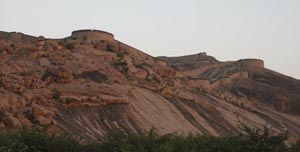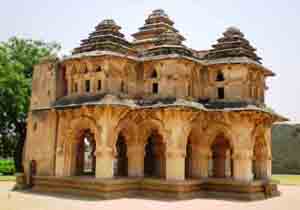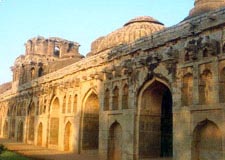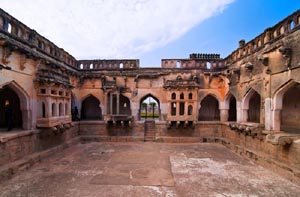Bellary Monuments - Historical Places to Visit in Bellary
Historical Monuments / Forts / Palaces / Places to Visit in Bellary
Here you can check list of names and information on famous historical forts / palaces / monuments / places to visit in Bellary, Karnataka, India. These famous monuments of Bellary are most visited and most sought after best tourist places. You can also find images of Bellary monuments / places / forts / palaces.
The Upper fortification houses the bastion from which can enter in the course of a zigzag rocky trail surrounded by shattered large rocks. On reaching one can determine on the apex, slight to the fortress, a small holy place, some completely clear and transparent ponds and carcass of some investment cells. After approaching the sanctuary, there are numerous well-constructed buildings and reservoir quarry in the rocks to endow for water storage.
Lotus Mahal is entirely constructed in stone. It is to be remembered that it is clear deviation from residential structure and palace conventional Vijayanagara period constructional methgods and patterns that largely used hard wooden structures on platforms made of massive stone. In its vaulted ceilings and arched gateways, this particular structure reflects Islamic influence. It is a pleasure pavilion. It served as a meeting place for the Emperor and his queen plus his closest advisors.
Singarada Hebbagrilu is primarily located at the backside of Elephant Stable in the Hampi district. It is one of the oldest gateways in the city as well as the state of Karnataka. Its beauty mainly lies in the huge door that the gateway has. There are two vast temples that lie within the gateway that further depicts the sacredness of the place. The structure was built during the 14th century. It is one of among the 300 heritage structures in the state of Karnataka.
Queen's Bath was built in the 14th century AD by the Vijayanagara kingdom. It was the bathing place for the royal women's for more than 3 centuries. Hampi was the capital of Vijayanaga Empire. They were known for building of temples, palaces and housing settlement in this area. Their architectural works were very unique that it still glorifies its Kingdom. This place is well known in the Indian history as a great capital, a war place and a flourishing city.
- Bangalore Monuments
- Bagalkot Monuments
- Belgaum Monuments
- Bellary Monuments
- Bidar Monuments
- Bijapur Monuments
- Chitradurga Monuments
- Coorg Monuments
- Dakshina Kannada Monuments
- Gadag Monuments
- Gulbarga Monuments
- Hassan Monuments
- Mysore Monuments
- Raichur Monuments
- Uttara Kannada Monuments
- Yadgir Monuments
- Andaman Nicobar Monuments
- Andhra Pradesh Monuments
- Assam Monuments
- Bihar Monuments
- Chhattisgarh Monuments
- New Delhi Monuments
- Goa Monuments
- Gujarat Monuments
- Haryana Monuments
- Himachal Pradesh Monuments
- Jammu and Kashmir Monuments
- Karnataka Monuments
- Kerala Monuments
- Madhya Pradesh Monuments
- Maharashtra Monuments
- Odisha Monuments
- Punjab Monuments
- Rajasthan Monuments
- Tamil Nadu Monuments
- Telangana Monuments
- Uttar Pradesh Monuments
- West Bengal Monuments



